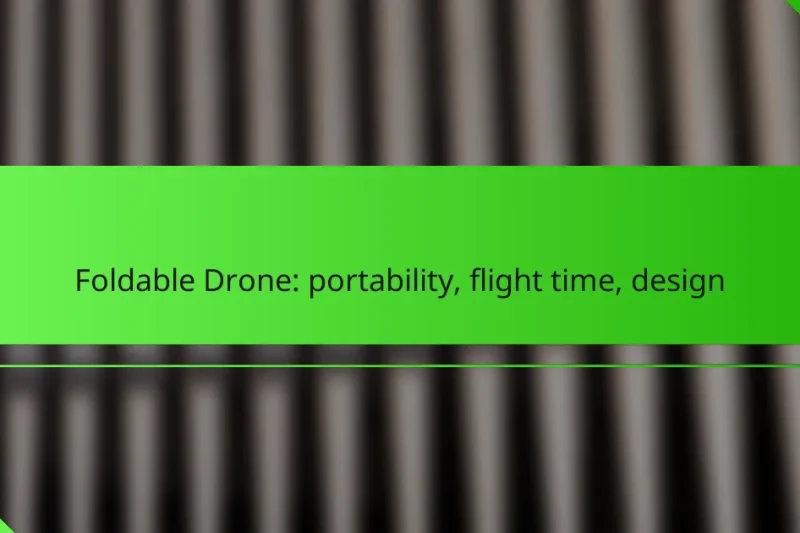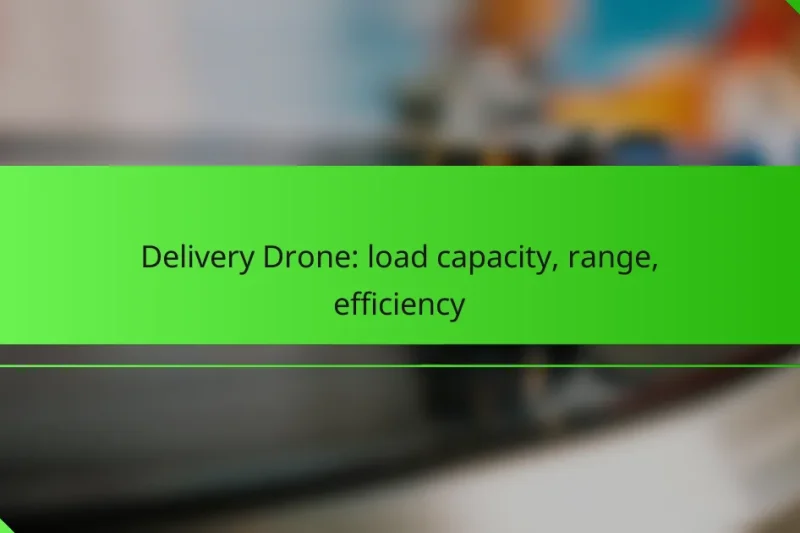Foldable drones are designed for maximum portability, making them perfect companions for travel and outdoor activities. … Foldable Drone: portability, flight time, designRead more
Choosing the Right Drone for Your Needs
Choosing the right drone involves understanding your specific needs, whether you’re a beginner, a photography enthusiast, or a commercial operator. For newcomers, user-friendly models like the DJI Mini SE offer an easy introduction, while photographers should prioritize camera quality and stability. Commercial users must consider performance and regulatory compliance to ensure efficiency in their operations.
Delivery Drone: load capacity, range, efficiency
Delivery drones are revolutionizing logistics with their varying load capacities, which can range from a few … Delivery Drone: load capacity, range, efficiencyRead more
What are the best drones for beginners?
The best drones for beginners are typically easy to fly, affordable, and equipped with user-friendly features. Options like the DJI Mini SE, Holy Stone HS720, and Snaptain SP350 offer a good balance of performance and simplicity, making them ideal for newcomers.
DJI Mini SE
The DJI Mini SE is a compact and lightweight drone that offers impressive stability and camera quality for beginners. Weighing under 250 grams, it does not require FAA registration in the U.S., making it a hassle-free option for new pilots.
With a flight time of around 30 minutes and a 2.7K camera, it provides excellent value for those wanting to capture high-quality aerial footage. Its intuitive controls and GPS-assisted features help ensure a smooth flying experience.
Holy Stone HS720
The Holy Stone HS720 is another great choice for beginners, featuring a 4K camera and a 26-minute flight time. Its foldable design makes it portable, and it comes with GPS-assisted flight modes that enhance stability and ease of use.
This drone also includes features like follow-me mode and waypoints, allowing users to explore various flying styles without extensive experience. However, it’s essential to familiarize yourself with its controls to maximize its capabilities.
Snaptain SP350
The Snaptain SP350 is an affordable entry-level drone that is perfect for those just starting. It offers a 720p camera and a flight time of about 10 minutes, making it suitable for casual flying and practice.
This model is equipped with one-key takeoff and landing, which simplifies the flying process for beginners. While it may lack some advanced features, it provides a solid foundation for learning the basics of drone operation.
How to choose a drone for photography?
Choosing a drone for photography involves evaluating several key features that impact image quality and usability. Focus on camera quality, stability features, and flight time to ensure you select a model that meets your specific needs.
Camera quality
The camera quality is crucial for capturing stunning aerial images. Look for drones with at least a 12 MP camera for decent photos, while models with 20 MP or more will provide sharper and more detailed images.
Additionally, consider the camera’s video capabilities. A drone that can shoot in 4K resolution will offer superior video quality, making it suitable for professional use. Check for features like adjustable ISO and shutter speed for better control over your shots.
Stability features
Stability features significantly affect the quality of your photos and videos. Drones equipped with gimbals help stabilize the camera during flight, reducing blurriness caused by vibrations or wind.
Look for drones with advanced GPS and altitude hold functions, which enhance stability and allow for smoother shots. These features are particularly important when flying in windy conditions or capturing long-exposure images.
Flight time
Flight time is an essential factor to consider when choosing a drone for photography. Most consumer drones offer flight times ranging from 20 to 30 minutes on a single charge, which is generally sufficient for capturing a variety of shots.
To maximize your shooting time, consider purchasing additional batteries. This allows for extended sessions without the need to return to recharge frequently. Keep in mind that heavier camera setups may reduce flight time, so balance your equipment accordingly.
What are the top drones for commercial use?
The top drones for commercial use include models that excel in performance, durability, and specialized features tailored for various industries. Key considerations include payload capacity, flight time, and regulatory compliance, which can significantly impact operational efficiency.
DJI Matrice 300 RTK
The DJI Matrice 300 RTK is a versatile drone designed for industrial applications, offering advanced AI capabilities and a robust flight platform. It features a maximum flight time of around 55 minutes and can carry multiple payloads, including thermal and zoom cameras.
This drone is particularly suited for surveying, mapping, and inspection tasks. Its RTK (Real-Time Kinematic) technology enhances positioning accuracy, making it ideal for projects requiring precise data collection.
Parrot Anafi USA
The Parrot Anafi USA is tailored for public safety and defense applications, featuring a compact design and impressive imaging capabilities. It offers 32x zoom and thermal imaging, which are essential for search and rescue operations or surveillance.
With a flight time of approximately 32 minutes, this drone is lightweight and portable, making it easy to deploy in various environments. Its user-friendly interface allows operators to quickly adapt to different missions.
Yuneec H520
The Yuneec H520 is designed for commercial use in fields like construction and agriculture. It provides a flight time of around 25 minutes and supports various payloads, including high-resolution cameras and sensors for data collection.
This drone is equipped with a six-rotor design, enhancing stability and redundancy during flight. Its intuitive controls and customizable features make it a solid choice for professionals needing reliable aerial data.
What factors should I consider when selecting a drone?
When selecting a drone, consider factors such as budget, intended use, and regulatory compliance. These elements will significantly influence your choice and ensure that the drone meets your specific needs.
Budget
Your budget is a primary factor in choosing a drone, as prices can vary widely. Entry-level models may cost a few hundred dollars, while professional-grade drones can exceed several thousand. Determine how much you are willing to invest based on your requirements.
Keep in mind that additional costs may arise from accessories, maintenance, and insurance. Setting a clear budget helps narrow down options and prevents overspending.
Purpose of use
Identify the primary purpose of your drone usage, whether it’s for recreational flying, photography, surveying, or racing. Different drones are designed for specific tasks, so understanding your needs will guide your selection.
For example, if you need aerial photography, look for drones with high-resolution cameras and stable flight capabilities. Conversely, racing drones prioritize speed and agility over camera quality.
Regulatory compliance
Familiarize yourself with local regulations regarding drone usage, as these can vary significantly by country. In the U.S., for instance, the FAA requires registration for drones over a certain weight and adherence to specific operational rules.
Ensure that the drone you choose complies with these regulations to avoid fines or legal issues. Researching local laws will help you understand any restrictions on flying locations, altitude limits, and necessary permits.
How do drone specifications impact performance?
Drone specifications significantly influence their performance by determining how well they can operate in various conditions. Key specifications such as battery life, range, and payload capacity directly affect flight duration, control distance, and the type of equipment the drone can carry.
Battery life
Battery life is crucial for determining how long a drone can stay airborne. Most consumer drones offer flight times ranging from about 15 to 30 minutes, depending on the model and battery capacity. Longer battery life allows for extended missions, but larger batteries can add weight, affecting overall performance.
When selecting a drone, consider your intended use. For example, if you plan to capture aerial photography, a drone with a longer battery life will enable you to take more shots without frequent landings for recharging.
Range and control
The range of a drone refers to the maximum distance it can fly from the controller while maintaining a stable connection. Typical ranges for consumer drones vary from a few hundred meters to several kilometers. A greater range allows for more extensive exploration and data collection, but it may require adherence to local regulations regarding line-of-sight operations.
When choosing a drone, ensure that its range aligns with your needs. For recreational flying, a shorter range might suffice, while professional applications may necessitate drones with extended operational distances.
Payload capacity
Payload capacity indicates how much weight a drone can carry, which is essential for tasks like aerial photography, surveying, or delivering packages. Most consumer drones can handle payloads ranging from a few hundred grams to several kilograms. Understanding the payload capacity helps in selecting appropriate equipment or accessories to attach to the drone.
Be mindful of the trade-offs; carrying heavier payloads can reduce flight time and stability. Always check the manufacturer’s specifications to ensure that your intended use does not exceed the drone’s payload limits, which can lead to performance issues or damage.
What are the best drones for racing?
The best drones for racing combine speed, agility, and durability, making them ideal for competitive environments. Key models include the EMAX Tinyhawk II and the Fat Shark 101, which cater to different skill levels and preferences.
EMAX Tinyhawk II
The EMAX Tinyhawk II is an excellent choice for beginners and intermediate racers. It features a lightweight design and robust construction, allowing for quick maneuvers and resilience during crashes.
This drone comes equipped with a 1S battery, providing flight times of around 4 to 6 minutes, depending on usage. Its 20000 KV motors deliver impressive speed, making it suitable for indoor and outdoor racing.
Fat Shark 101
The Fat Shark 101 is designed for those who want a more advanced racing experience. It offers a higher speed range and better control, appealing to seasoned pilots looking for competitive edge.
This model includes a 3S battery option, which can extend flight times to about 8 minutes under optimal conditions. Its advanced features, such as adjustable camera angles and customizable settings, allow for a tailored racing experience.

